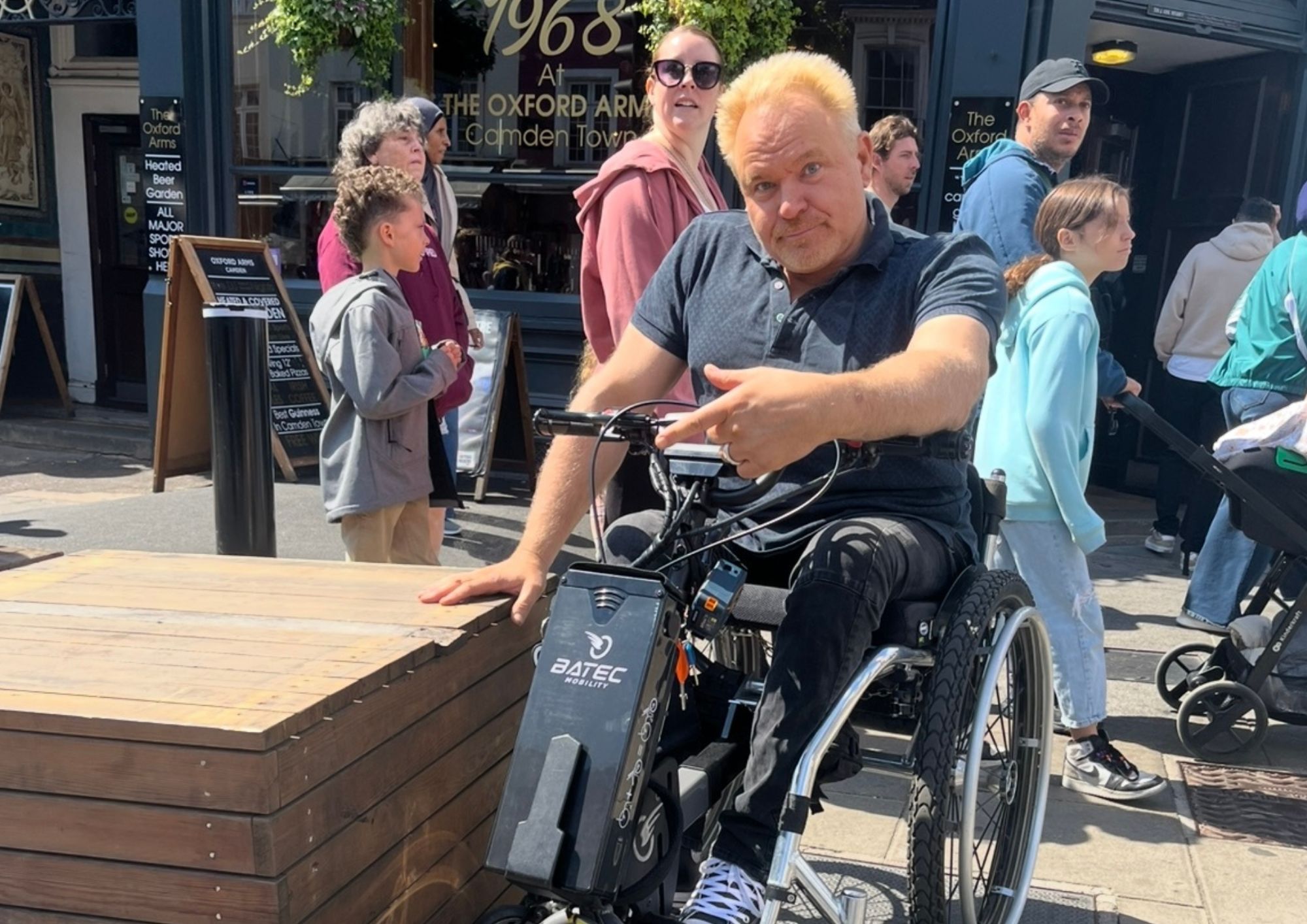Nice idea to go car free – but tourists have disabilities too, council warned
Campaigner says changes to Camden High Street do not measure up
Friday, 16th May — By Caitlin Maskell

Mik Scarlett in part-pedestrianised Camden High Street
A scheme to pedestrianise part of Camden High Street has been hailed as a win for clean air and safer streets for visitors.
But disabled residents say the way the barriers and bollards have been installed has left them feeling frozen out.
Camden Council is two weeks into an 18-month trial of the measures which has closed off a section from the tube station to Jamestown Road to traffic.
Cars and buses are heading down Kentish Town Road instead, although cyclists are still using the High Street.
A decision on whether to make it permanent will be reached at the end of next year.
But this week journalist campaigner and award-winning TV presenter Mik Scarlet outlined why people with disabilities are so angry about how the changes have been implemented.
He said: “I think we can make Camden one of the leading accessible areas with very little effort. “But there is this real disconnect with the councillors who have been told this is accessible and the council staff. I don’t know who they are listening to but it’s not anyone disabled.”
Mr Scarlet, who survived cancer but was left paralysed and using a wheelchair as a teenager due to complications with his treatment, said: “We have a pedestrianisation that has stopped anyone that doesn’t use legs – and even those people that do use legs but don’t have eyes.
“The worst bit is it’s all for tourism but disabled people are also tourists. Disabled people all over the world dream of coming here and I have to be honest with them and tell them the accessibility is bad.”

Mr Scarlet’s research shows the new barriers don’t measure up
Near Jamestown Road, one of the new gates used to stop traffic on the road has been placed on a pedestrian crossing.
Those who are visually impaired and feel tactile pavements will assume a crossing and be at risk of colliding with the barriers.
Mr Scarlet added: “Even if this was temporary – and it cost £400,000 – temporary things have to be compliant. They have to be safe, it has to be accessible.”
Rosemary Nicholson from the organisation Visually Impaired in Camden said there were repeated and continuous issues with accessibility in Camden’s consultations.
“It doesn’t matter what we say, Camden doesn’t care,” she added.
“Once Camden launches a consultation, there’s no point in responding anymore, because they’ll just go ahead with it whatever.
“The experimental orders, which are 18 months, are hardly experimental. One of the things that really is problematic for visually impaired people is the continuous pavements are raised and drivers don’t know who has priority putting pedestrians at risk.
“It just makes people scared to go out and people have been imprisoned in their homes again, because that’s the only choice they have to be safe.”

The new barriers in Camden High Street
Tom McDonough from Camden Disability Action, said: “While many disabled people will benefit from a traffic-free and less packed Camden High Street such as some of those with autism, mental health conditions or visual or mobility conditions, others, such as wheelchair users and people with severe pain may struggle to make use of the new environment unless adaptations are made.
“We’ve heard that Camden consulted some specific stakeholders and commissioned an accessibility audit, but we were not consulted on this change and first learned of it from the press. To its credit, Camden has involved us in other work on street-changes in Camden, but this involvement needs to be consistent and our voices needed to properly heard. If street changes work for all disabled people, they will work for others too.”
Councillor Adam Harrison, Cabinet Member for Planning and a Sustainable Camden said: “For many years, the high street has been a place where busy pavements create significant overcrowding.
“These are the first early steps in an 18-month trial. We are actively looking at what changes to make based on the council’s own observations of how people are now using the space and on what residents and businesses have told us. The benefit of doing this as a trial is that we can make such changes in a responsive way.”